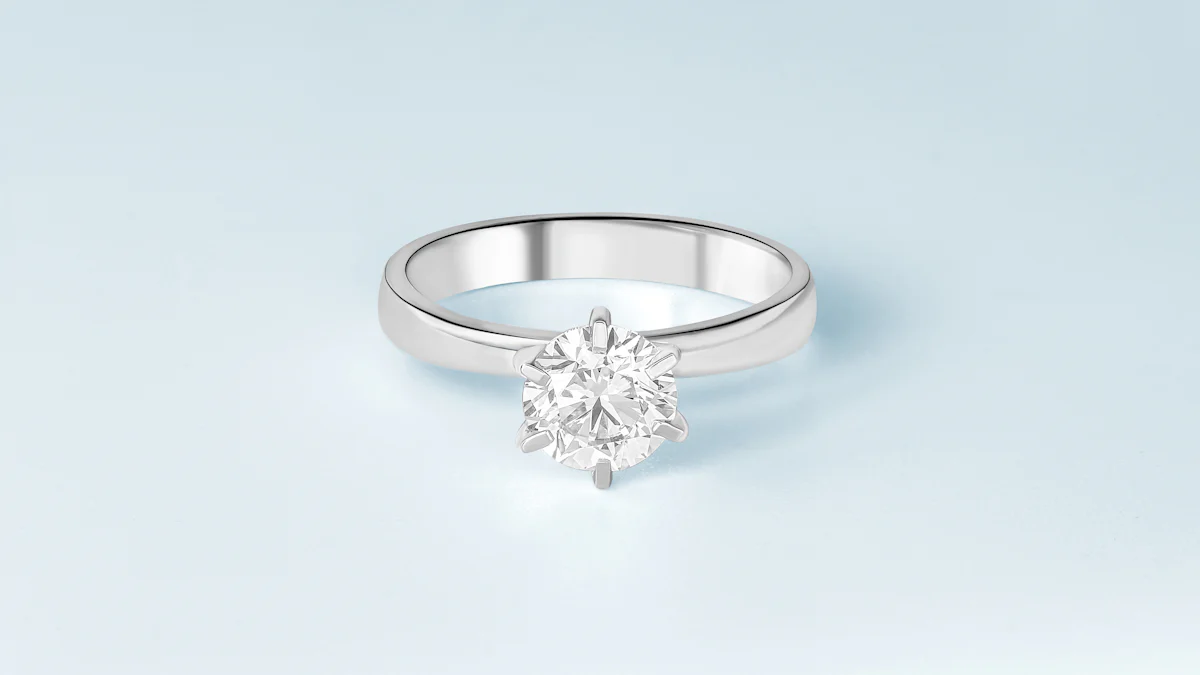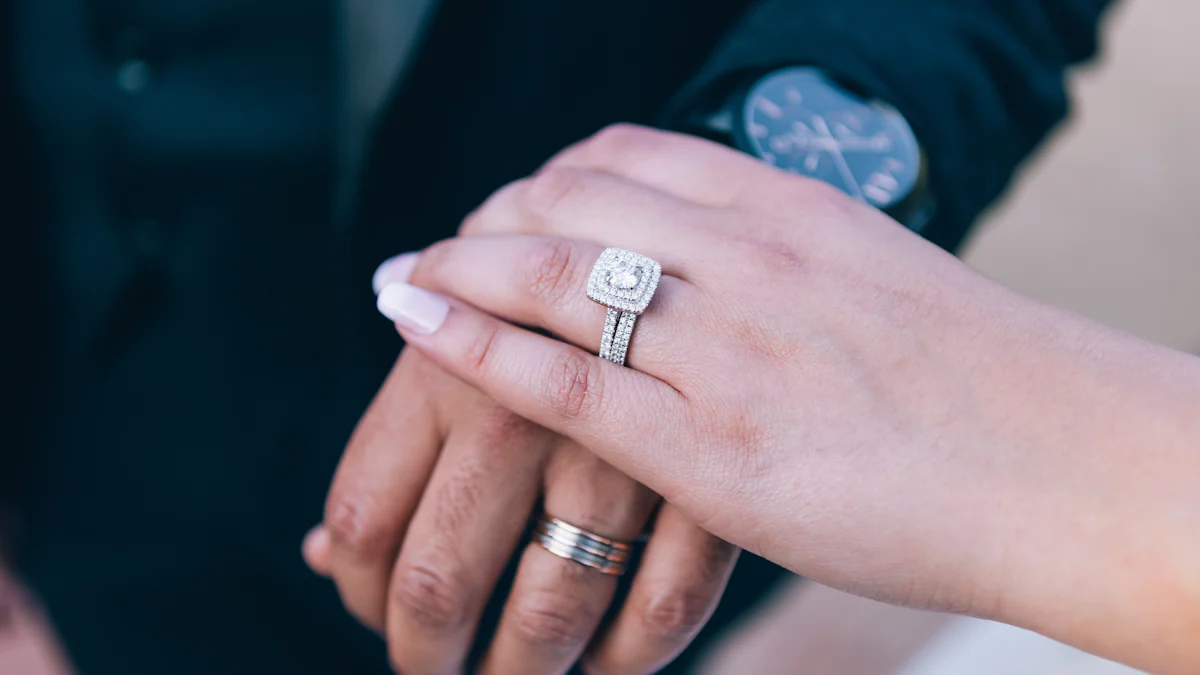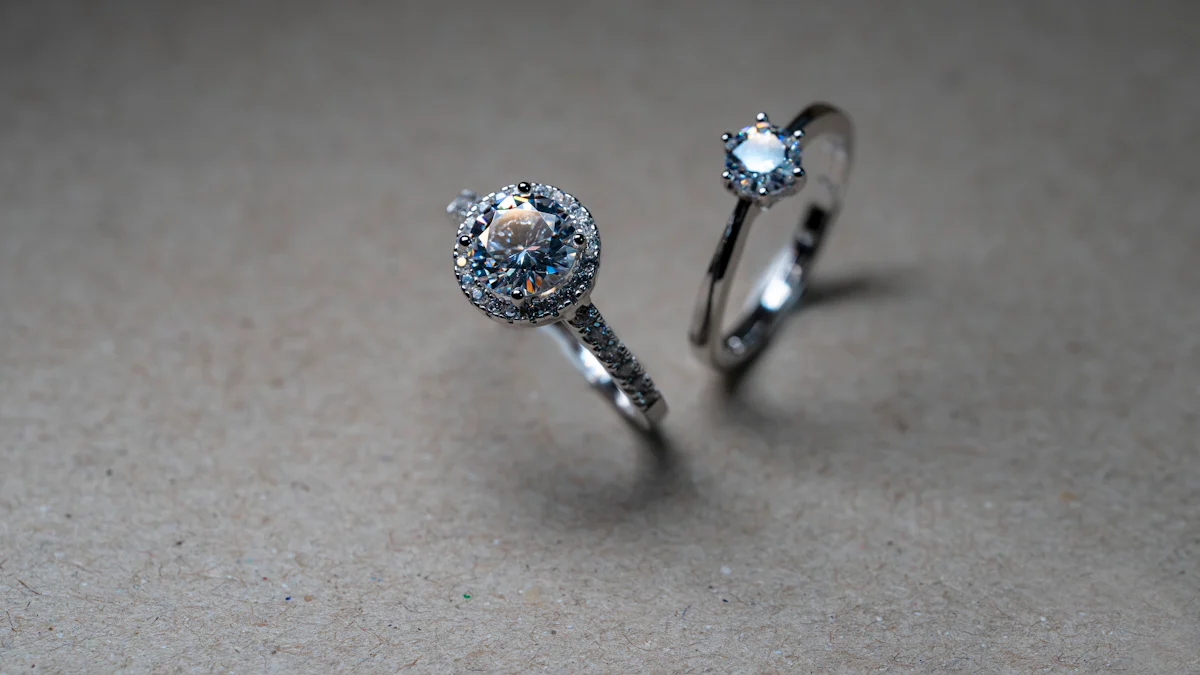1 Carat vs 2 Carat Diamonds: Key Differences

When choosing between a 1 carat vs 2 carat diamond, you encounter several main differences that can influence your decision. The size difference is noticeable; a 2 carat diamond appears significantly larger than a 1 carat, making it a striking choice for an engagement ring. However, this increase in size comes with a higher price tag. The cost of a diamond doesn't just double with carat weight; it increases exponentially. While a 1 carat diamond ring might fit comfortably within your budget, a 2 carat diamond ring could stretch it. Despite the size, both diamonds can offer similar brilliance and sparkle, depending on their cut and quality. Ultimately, your choice should reflect your personal style and financial considerations.
Understanding Carat Weight
When you're shopping for diamonds, understanding carat weight is crucial. This guide will help you grasp the basics and see how carat weight impacts your choice between a 1 carat diamond and a 2 carat diamond.
What is a Carat?
A carat is a unit of weight used to measure diamonds and other gemstones. One carat equals 200 milligrams. It's important to note that carat weight doesn't always equate to size. Two diamonds of the same carat can look different based on their cut and shape. When you consider a 1 carat diamond or a 2 carat diamond, you're essentially looking at the weight of the stone.
How Carat Weight Affects Appearance
Visual Size Differences
The visual difference between a 1 carat diamond and a 2 carat diamond is significant. A 2 carat diamond appears larger and more prominent. This size difference can make a big impact on how the diamond looks on your finger. A 1 carat diamond might seem more subtle, while a 2 carat diamond often stands out as a statement piece.
Perceived Brilliance and Sparkle
Carat weight can also influence how you perceive a diamond's brilliance and sparkle. Larger diamonds, like a 2 carat diamond, have more surface area to reflect light, potentially enhancing their sparkle. However, the cut quality plays a crucial role in this aspect. A well-cut 1 carat diamond can shine just as brightly as a larger one if it has excellent cut proportions.
Carat Weight and Budget Considerations
When it comes to budget, carat weight is a major factor. A 2 carat diamond typically costs more than a 1 carat diamond. The price doesn't just double; it increases exponentially due to the rarity of larger stones. If you're working within a budget, a 1 carat diamond might be a more practical choice. It offers a balance between size and cost, allowing you to invest in other aspects like cut, color, and clarity. This guide emphasizes that your decision should align with your financial situation and personal preferences.
The Four Cs of Diamonds
When you're choosing between a 1 carat and a 2 carat diamond, understanding the Four Cs is essential. These factors—cut, color, clarity, and carat—determine the diamond's overall quality and value. Let's dive into each one.
Cut
The cut of a diamond is crucial. It refers to how well the diamond has been shaped and faceted. A well-cut diamond reflects light beautifully, enhancing its brilliance. You might think of cut as the craftsmanship behind the diamond. It's not about the shape or size but about how the diamond interacts with light. A diamond with an excellent cut will sparkle more, making it appear more vibrant. When you're comparing diamonds, prioritize cut. It significantly impacts the diamond's appearance and allure.
Color
Color in diamonds ranges from colorless to light yellow or brown. The less color a diamond has, the higher its quality. A colorless diamond allows more light to pass through, resulting in more sparkle. When you look at a diamond, you want it to appear clear and bright. The Gemological Institute of America (GIA) grades diamond color from D (colorless) to Z (light color). For most people, diamonds in the D to F range offer the best balance of quality and value.
Clarity
Clarity measures the purity of a diamond. It assesses the presence of tiny flaws, known as inclusions and blemishes. The fewer the imperfections, the clearer and more brilliant the diamond becomes. Jewelers use a scale to rate clarity, from FL (flawless) to I (included). While flawless diamonds are rare and expensive, many inclusions are microscopic and don't affect the diamond's beauty. When selecting a diamond, consider clarity, but remember that minor inclusions often go unnoticed to the naked eye.
Understanding these aspects helps you make an informed decision. Each C plays a role in the diamond's overall quality and appeal. By focusing on these factors, you can find a diamond that suits your style and budget.
Carat
When you think about diamonds, carat often comes to mind first. It's a key player in the Four Cs, but what makes it so important?
Importance of Carat in the Four Cs
Carat weight directly influences a diamond's size and, consequently, its visual impact. A 1 carat diamond might seem modest, while a 2 carat diamond often makes a bold statement. This difference in size can affect how you perceive the diamond's presence on your finger. However, carat isn't the only factor that determines a diamond's value. The cut, color, and clarity also play significant roles. For instance, a well-cut 1 carat diamond can outshine a poorly cut 2 carat diamond. The brilliance and sparkle depend heavily on the cut quality, not just the carat weight.
Balancing Carat with Other Cs
Finding the right balance between carat and the other Cs is crucial. You might be tempted to go for a larger carat weight, but remember that cut, color, and clarity are equally important. A 2 carat diamond with poor clarity or color might not look as appealing as a smaller, higher-quality stone. When choosing between a 1 carat and a 2 carat diamond, consider your priorities. Do you value size over sparkle, or do you want a diamond that dazzles regardless of its carat weight? By balancing these factors, you can find a diamond that fits your style and budget perfectly.
Size and Visual Appeal

When you're deciding between a 1 carat and a 2 carat diamond, size plays a significant role in your choice. Let's explore how these sizes compare and how they impact the design and setting of your jewelry.
Comparing 1 Carat and 2 Carat Sizes
The difference in size between a 1 carat and a 2 carat diamond is quite noticeable. A 1 carat diamond typically measures around 6.5 mm in diameter, while a 2 carat diamond measures approximately 8 mm. This increase in size makes the 2 carat diamond appear more prominent and eye-catching. You might find that a 2 carat diamond stands out more, making it a popular choice for those who want their jewelry to make a statement.
However, it's essential to remember that size isn't everything. The cut of the diamond can significantly affect its appearance. A well-cut 1 carat diamond can look just as stunning as a larger stone. The brilliance and sparkle of a diamond depend heavily on its cut quality, not just its carat weight. So, when you're comparing sizes, consider how the cut enhances the diamond's overall appeal.
Impact on Jewelry Design and Setting
The size of your diamond influences the design and setting of your jewelry. A 1 carat diamond offers versatility, fitting well into various settings without overwhelming the design. It provides a classic and timeless look, perfect for those who prefer subtle elegance.
On the other hand, a 2 carat diamond often requires a more robust setting to support its weight and size. This can lead to more elaborate designs that highlight the diamond's grandeur. If you choose a 2 carat diamond, you might opt for a setting that showcases its size, such as a halo or a solitaire setting. These designs can enhance the diamond's visual impact, making it the centerpiece of your jewelry.
Ultimately, your choice between a 1 carat and a 2 carat diamond should reflect your personal style and how you want your jewelry to look. Whether you prefer the understated elegance of a 1 carat diamond or the bold presence of a 2 carat diamond, understanding how size affects design and setting will help you make an informed decision.
Price and Value

When you're deciding between a 1 carat diamond and a 2 carat diamond, understanding the price differences is crucial. The cost of a diamond doesn't just increase linearly with its carat weight. Instead, it rises exponentially. This means a 2 carat diamond can cost significantly more than a 1 carat diamond. The larger size of a 2 carat diamond makes it more impressive and eye-catching, often making it a bold statement piece for an engagement ring. However, this dramatic gesture comes with a hefty price tag.
Price Differences Between 1 Carat and 2 Carat Diamonds
The price difference between a 1 carat diamond and a 2 carat diamond can be substantial. A 1 carat diamond might fit comfortably within your budget, offering a balance of size and affordability. It's an ideal choice for many looking for a classic engagement ring without breaking the bank. On the other hand, a 2 carat diamond, due to its larger size and rarity, commands a higher price. This makes it a luxurious option for those who want their diamond engagement ring to stand out.
Factors Influencing Diamond Value
Several factors influence the value of a diamond beyond just its carat weight. Understanding these can help you make a more informed decision.
Market Trends
Market trends play a significant role in determining diamond prices. The demand for larger diamonds, like a 2 carat diamond, often fluctuates based on fashion trends and consumer preferences. When larger diamonds are in vogue, their prices can soar. Keeping an eye on these trends can help you decide the best time to purchase your diamond engagement ring.
Rarity and Demand
Rarity significantly impacts a diamond's value. Larger diamonds, such as a 2 carat diamond, are rarer than smaller ones. This rarity makes them more desirable and, consequently, more expensive. The demand for these larger stones can drive up prices even further. A 1 carat diamond, while still valuable, is more common and thus more affordable. When choosing between the two, consider how rarity and demand affect the overall cost and value of your engagement ring.
Ultimately, your choice between a 1 carat diamond and a 2 carat diamond should reflect your personal style and budget. Whether you prefer the understated elegance of a 1 carat diamond or the bold presence of a 2 carat diamond, understanding the price and value factors will guide you in making the right decision for your diamond engagement ring.
Making the Right Choice
Choosing between a 1 carat diamond ring and a 2 carat diamond ring can feel overwhelming. You want the perfect engagement ring that reflects your style and fits your budget. Let's explore how personal preferences, lifestyle, and financial considerations can guide you in making the right choice.
Personal Preferences and Lifestyle
Your personal style and lifestyle play a huge role in selecting the perfect engagement ring. Do you prefer something subtle and classic? A 1 carat diamond ring might be your ideal match. It offers elegance without being too flashy. If you love making a statement, a 2 carat diamond ring could be the way to go. Its larger size catches the eye and adds a touch of luxury.
Consider your daily activities. If you lead an active lifestyle, a 1 carat diamond ring might be more practical. It’s less likely to snag or get in the way. On the other hand, if you enjoy dressing up and attending events, a 2 carat diamond ring can complement your outfits beautifully. Think about how the ring will fit into your everyday life and special occasions.
Budget and Financial Considerations
Budget is a crucial factor when buying a diamond ring. The price of diamonds increases exponentially with carat weight. A 2 carat diamond ring typically costs much more than a 1 carat diamond ring. Larger diamonds are rarer, which drives up their price. If you're working with a limited budget, a 1 carat diamond ring might be a more feasible option. It allows you to invest in other aspects like cut, color, and clarity.
When planning your purchase, consider how much you're willing to spend. Set a budget that aligns with your financial situation. Remember, the perfect engagement ring doesn't have to break the bank. It's about finding a balance between what you love and what you can afford.
Tips for Choosing the Right Carat Size
Here are some tips to help you choose the right carat size for your perfect engagement ring:
- Prioritize Cut Over Carat: A well-cut diamond can enhance brilliance and sparkle, making even a smaller diamond shine brightly.
- Consider Ring Setting: Certain settings can make a diamond appear larger. A halo setting, for example, can add extra sparkle and create the illusion of a bigger stone.
- Think About Finger Size: A 2 carat diamond ring might look overwhelming on smaller fingers, while a 1 carat diamond ring can offer a balanced look.
- Try Different Sizes: Visit a jeweler and try on different carat sizes. Seeing them on your finger can help you decide which size feels right.
- Consult a Diamond Buying Guide: Educate yourself on the Four Cs and how they affect diamond quality and appearance.
Ultimately, the right choice depends on your personal preferences, lifestyle, and budget. Whether you choose a 1 carat diamond ring or a 2 carat diamond ring, the most important thing is that it feels perfect for you.
Choosing between a 1 carat and a 2 carat diamond involves weighing several factors. The size difference is evident, with the 2 carat diamond offering a more striking presence. However, this comes with a higher price tag. Your decision should reflect your personal style and budget. Consider how the diamond fits into your lifestyle and financial plans. Remember, the perfect diamond isn't just about size; it's about finding the right balance that suits you. Whether you opt for the subtle elegance of a 1 carat or the bold statement of a 2 carat, make sure it feels right for you.
FAQ
What is the main difference between a 1 carat and a 2 carat diamond?
The primary difference lies in their size and weight. A 1 carat diamond weighs 200 milligrams, while a 2 carat diamond weighs 400 milligrams. This weight difference makes the 2 carat diamond appear significantly larger. However, the choice between the two often depends on personal preferences and budget considerations.
How does carat weight affect the price of a diamond?
Carat weight significantly impacts the price. The cost of a diamond increases exponentially with its carat weight. This means a 2 carat diamond can be much more expensive than a 1 carat diamond. Larger diamonds are rarer, which drives up their price. When choosing, consider how much you're willing to spend and what fits your budget.
Does a larger diamond always mean better quality?
Not necessarily. While a larger diamond may have more visual impact, its quality depends on other factors like cut, color, and clarity. A well-cut 1 carat diamond can shine just as brightly as a larger one. It's important to balance these factors to maximize the diamond's value and appearance.
How can I make a smaller diamond appear larger?
Certain settings can enhance the appearance of a smaller diamond. For example, a halo setting surrounds the center stone with smaller diamonds, creating the illusion of a larger diamond. Additionally, choosing a well-cut diamond can enhance its brilliance and make it appear more substantial.
Should I prioritize carat weight over cut, color, and clarity?
While carat weight affects size, the cut, color, and clarity determine the diamond's overall beauty and sparkle. Prioritizing cut can enhance the diamond's brilliance, making even a smaller diamond shine brightly. Consider all factors to find a diamond that suits your style and budget.
How do market trends affect diamond prices?
Market trends can influence diamond prices. When larger diamonds are in demand, their prices may rise. Keeping an eye on these trends can help you decide the best time to purchase a diamond. However, personal preference and budget should guide your decision more than market fluctuations.
Can I save money by compromising on clarity or color?
Yes, you can save money by finding a balance between color and clarity. Staying on the high end of the color scale and the lower end of the clarity scale can help you save without sacrificing quality. Many inclusions are microscopic and don't affect the diamond's beauty to the naked eye.
Is a 2 carat diamond too flashy for everyday wear?
This depends on your personal style and lifestyle. A 2 carat diamond makes a bold statement and can be perfect for those who enjoy making an impression. However, if you prefer subtle elegance, a 1 carat diamond might be more suitable for everyday wear.
How do I choose the right carat size for my engagement ring?
Consider your personal preferences, lifestyle, and budget. Try on different sizes to see what feels right. Think about how the ring will fit into your daily life and special occasions. Ultimately, choose a diamond that reflects your style and feels perfect for you.
See Also
What Is the Price of a 2 Carat Lab Diamond
What Size Does a 2.25 Carat Diamond Have
Essential Elements That Influence Diamond Ring Costs

